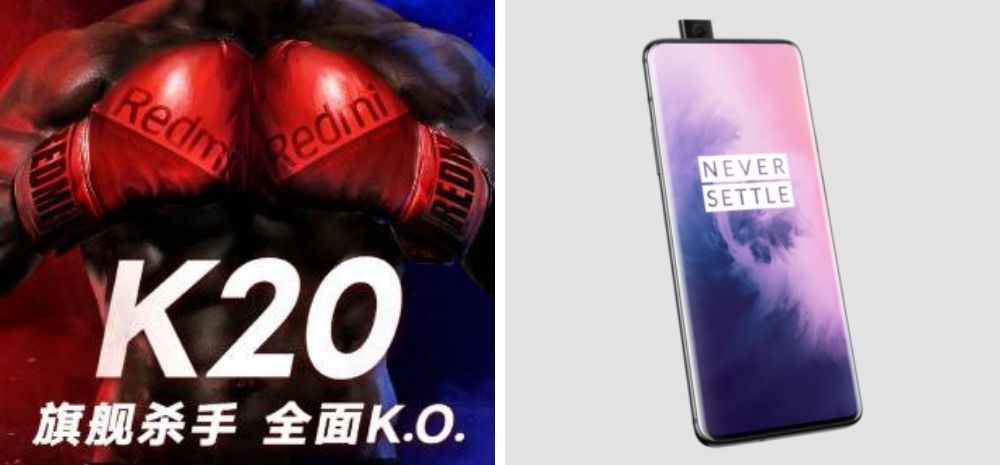Redmi K20 Pro Vs OnePlus 7: What’s Common, Better & Different? [Strategic Comparison]

Can Xiaomi again hit OnePlus hard? The company last year came with Poco F1, the rest is history. OnePlus lost the top spot in the premium smartphone segment, a crown it held for over three straight quarters.
Later the company was forced to launch its latest OnePlus 7 at a 6 percent lesser price compared to the predecessor.
Redmi K20 Pro offer a lot of features as the top model, the OnePlus 7 Pro, as Snapdragon 855, notch-less display, pop-up sensor, 48MP Sony sensor inside a three camera setup, in-display fingerprint sensor and such more.
Let’s check out who’s going to lead the flagship space in the country in 2019.
Contents
Design & Build Quality: Glass vs Metal
OnePlus 7 comes with a similar design as the predecessor, while Redmi K20 Pro sports a full glass body. Both the smartphones come with in-display fingerprint sensors. As an add-on, Xiaomi hasn’t ditched the 3.5mm headphone jack.
OnePlus 7 sports the same water drop notch display and an in-display fingerprint sensor embedded inside the screen, with an added stereo speakers this time.
In comparison, Redmi K20 Pro features a body mixed up of glass and metal. With a 3D gradient at the back, the smartphone dons a compact design with curved sides at back. It feels more premium compared to the current generation regular OnePlus flagship.
Edge To Edge Bezel-Less Display: Notch vs Pop-Up Sensor
OnePlus 7 sports a 6.4-inch Full HD+ water drop notched display with Corning Gorilla Glass protection. It’s a Super AMOLED display, but not the super smooth one being used in the OnePlus 7 Pro model with refresh rate upto 90Hz.
In comparison, Redmi K20 Pro has no notch. Redmi K20 Pro sports a 6.39-inch Full HD+ Super AMOLED display without any notch in a 19.5:9 aspect ratio offering around 91 percent screen to body ratio.
Redmi K20 Pro without any notch does look better and more stylish. It uses a pop-up sensor to get rid off the notch and offer a full-screen display.
Hardware & Storage: Unleashing The Best
Both the smartphones are powered by the best Qualcomm processor in the market, the octa-core Qualcomm Snapdragon 855. The chip on K20 Pro and OnePlus 7 pairs with up to 12GB and 8GB of RAM respectively alongside a well-improved Adreno 640 GPU to take control of the graphics.
Thanks to Snapdragon 855, both the devices can run anything you throw at it.
OnePlus 7 with the near stock Android UI on top makes the job easy for the smartphone. In terms of daily performance and efficiency, you can rely on both without a second thought.
Redmi K20 Pro with MIUI 10 has some extra bloatware with additional customisations. In all, both K20 Pro and OnePlus 7 can easily run memory heavy apps with adequate RAM management.
Software: Near Stock Android Or MIUI?
OnePlus too offers a great UI with the newly improved Oxygen OS. It’s flawless, and does help to offer an easy and refined experience on the smartphone. On the other hand, Redmi K20 Pro runs on Android 9 Pie-based MIUI 10.
On both the devices you will get instant access to the Android Q beta program.
In comparison to MIUI, OnePlus have done a great job with the new OxygenOS to offer an almost stock-looking Android interface with just a number of customisations. The user experience on OnePlus 7 is truly phenomenal.
Cameras & Photography: Two Vs Three
Both OnePlus 7 and Redmi K20 pro features the Sony IMX 586 48MP lens as their primary sensors. OnePlus 7 comes with the 48-megapixel Sony IMX 586 lens with an f/1.7 aperture and a 5-megapixel depth sensor. In comparison, Redmi K20 Pro features a three camera set up at the back.
The rear triple camera system on K20 Pro features the 48MP Sony IMX586 camera as the primary lens with an f/1.75 aperture coupled with an 8MP telephoto secondary sensor with an f/2.4 aperture and a tertiary 13MP wide-angle sensor with an f/2.5 aperture and a 124.8-degree field of view.
Both do a fair job offering a great dynamic range with almost accurate colours irrespective of lighting conditions. They support Google Camera and dedicated Night Mode for long-exposed shots.
Redmi K20 Pro with the additional sensor will offer some extra advantage. OnePlus 7 on the other hand lacks a third lens, but certainly does a decent job in terms of overall photography.
Battery & Fast Charging: Same?
Redmi K20 Pro houses a huge 4,000 battery. The smartphone supports AI smart optimization to extend the phone’s battery to last longer and will come with a 27W fast charger in the box.
OnePlus 7 has a smaller battery, a 3,700mAh unit backed by the same old fast charging adapter from OnePlus 6T.
Pricing: Who Wins?
OnePlus 7 starts at Rs 32,999 for the base model with 6GB RAM and 128GB storage. In India, Asus 6Z should also start at around 30,000 rupees to match up with the competition. Xiaomi is yet to reveal anything about Redmi K20, but the company is going to be very aggressive with the price, maybe around Rs 25,000.
Redmi K20 Pro is available in four variants in China. It has been launched starting at 2,499 yuan (around Rs 25,250) for the base model with 6GB RAM and 64GB storage. The mid-version model with 6GB RAM and 128GB storage costs 2,599 yuan (around Rs 26,250).
Finally, the top-end models featuring 8GB RAM with 128GB storage and 8GB RAM with 256GB storage is priced at 2,799 yuan (around Rs 28,250) and 2,999 yuan (around 30,250) respectively.

Comments are closed, but trackbacks and pingbacks are open.